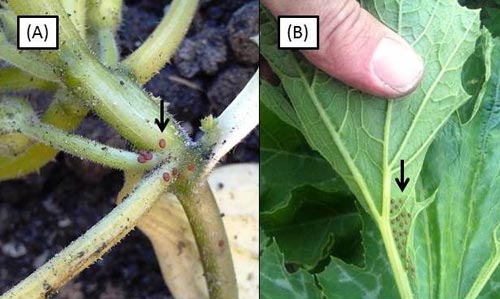Pest Free Vegetables
Knowledge is power when it comes to controlling insect pests of vegetables, and one of the key sources of knowledge is pest monitoring. Pest monitoring, or scouting, allows you to determine when pests arrive in your vegetables, which species are present and how many there are. This information in turn allows you to determine if actions need to be taken to control pests and if these prevent enough damage to offset costs of control. By analogy, an army commander that knows when an enemy will attack, what types of weapons they have and their troop strength will be able to make intelligent decisions about if, when and how countermeasures will be effective. Just like armed forces use reconnaissance to get this information, you can use monitoring to keep track of insects attacking your vegetables.
For some insect pests and life stages, including onion thrips, eggs of Colorado potato beetles,caterpillars in cole crops and squash bugs, the easiest way to track numbers is to get down on your hands and knees and count these pests on the plants they are attacking. In order to make this scouting technique effective, you will need to know when and where to find pests within a field. For example,striped cucumber beetle adults overwinter in non-crop habitats and move from these areas into edges of cucurbit fields starting in early spring. As a result, early in the season this pest is most easily detected in edges of cucurbit fields.
It is also important to know which part of plants pests can be found on to make the most of your time. For example, eggs of squash vine borer are more typically found on stems at the base of cucurbit plants (Photo 1A). In contrast, egg masses of squash bug are located on the underside of leaves, often at the junction of leaf veins (Photo 1B).

Photo 1. Different pest species and life stages can be found in different places, which is important to know when scouting. For example, in cucurbits, squash vine borer eggs (A) are typically laid on plant stems, while squash bug eggs (B) are often laid underneath leaves where two leaf veins meet.
The next step is to determine how you will walk your field. Being strategic about this will allow you to count plants scattered throughout your crop, helping you avoid making control decisions based on a small area not representative of the rest of your crop. One way to achieve this is to walk a V, X, W, zigzag or diamond-shaped path through your planting (Photo 2) and to start walking these paths from a different spot each time you scout that area.

Photo 2. Walk a path that allows you to scout pests throughout your crop. Panels A and B show two paths you could walk to do this. Avoid scouting only in one area, as in panel C, which may not be representative.
Next, determine how many plants you will count. There are at least two approaches for making this decision. One approach is to choose a fixed number of plants to count that, based on Extension literature or experience, you are confident will give you good information. For example, when scouting for onion thrips you can count 50 plants, counting 10 plants at five locations throughout a field.
Alternatively, if it is available, you can use what is called a sequential sampling plan. In this approach you count a set number of plants, then compare this to an upper and lower count threshold to determine if you need to count more plants to make a good decision. A good example is sampling plans for onion thrips and botrytis leaf blight. See an explanation of how to use scouting sheets for this approach, along with an example from grapes.
In general, the more plants you count, the more confident you can be you have the data needed to make a good control decision.
Finally, one of the biggest benefits of scouting is that it gets you into your crop, helping you learn and increase the chances you will notice problems before they get out of control. For example, you may notice beneficial predators and parasitoids that attack pests, which you can’t see from your truck. Being more aware of these beneficials may encourage you to change how you use insecticides.
You can also kill multiple birds with one stone by scouting for multiple pests, diseases and nutrient deficiencies at the same time. Being present in your field on a weekly basis can help you detect these problems and take prompt action.
Once you detect a pest problem, the next step is to decide whether or not control is warranted, which may include cultural, chemical or biological controls.

Comments
Post a Comment